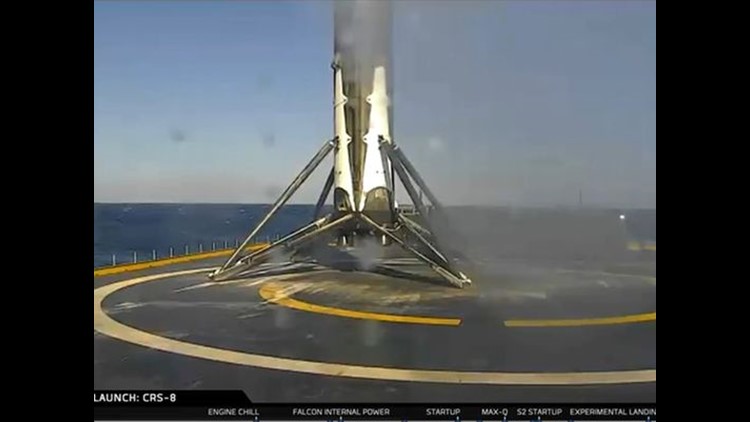CAPE CANAVERAL — The first stage of a SpaceX Falcon 9 rocket almost hit the bull's eye Friday, landing on a barge about 200 miles offshore.
Though not exactly in the center of the platform, the maneuver was enough to keep the equipment from getting wet in the Atlantic Ocean. The experiment was the first successful landing.
The booster possibly could have returned to land, like one did in December, SpaceX said. But an ocean landing would be less difficult and good practice for several upcoming missions.
The rocket lifted off on time and as envisioned Friday. Its Dragon cargo capsule was continuing on to the International Space Station.
Meteorologists at the Air Force's 45th Weather Squadron had anticipated a 90% chance of acceptable conditions during the instantaneous window at Cape Canaveral Air Force Station's Launch Complex 40.
The primary weather concern for launch was liftoff winds.
SpaceX late Tuesday completed a practice countdown that culminated with a brief test-firing of the rocket's nine Merlin main engines, a standard pre-launch milestone, and said engineers were reviewing the data.
The company launched its first Dragon spacecraft since June when its Falcon 9 rocket failed about 2 minutes after liftoff. No Dragon has visited the space station in a year.
The launch will be SpaceX's fourth since December and third of an upgraded Falcon 9 rocket providing more thrust at liftoff.
Among the cargo the Dragon is delivering to the station is a prototype expandable module designed by Bigelow Aerospace, which over two years will test technology that could underpin a future space station or deep space habitat.
“It is the future,” said Kirk Shireman, head of NASA’s space station program. “Humans will be using these kinds of modules as we move further and further off the planet, and actually as we inhabit low Earth orbit.”
The Dragon is packed with nearly 7,000 pounds of food, supplies and experiments, almost half of which is accounted for by the Bigelow module loaded in the capsule's "trunk.”
Made of layers of soft, reinforced materials around a metal core, the module builds upon technology NASA started developing in the 1990s as a potential space station crew quarters, before cancelling the TransHab program.
Once referred to as “inflatable,” the habitats are now called “expandable” to convey something more structured and less fragile.
“Inflatables makes you think of things like balloons,” said Jason Crusan, director, NASA’s Advanced Exploration Systems Division. “An expandable structure is more like a tent. In a packed configuration, it fits neatly in your car and your backpack. When you go to a site and you set it up, you can open the windows, you can get in it and get out of it, it keeps its structure at that point.”
If you do imagine a balloon, think of one wrapped in a Kevlar-like vest, able to withstand high-speed strikes by space debris even better than metal hulls, said Robert Bigelow, the president of Bigelow Aerospace and owner of the Budget Suites of America hotel chain.
“It’s so incredibly strong, it will maintain its shape,” he said.
The technology makes it possible to fit a large living and working area inside a rocket's nose cone, saving on space and possibly weight, without needing something like the space shuttle that launched U.S. modules to the space station.
Follow James Dean on Twitter: @flatoday_jdean



